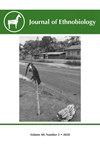Negotiating the Futures of Nature and Cultures: Perspectives from Indigenous Peoples and Local Communities about the Post-2020 Global Biodiversity Framework
IF 1.3
3区 社会学
Q1 ANTHROPOLOGY
引用次数: 8
Abstract
Abstract. A post-2020 Global Biodiversity Framework is currently under negotiation under the auspices of the Convention on Biological Diversity (CBD). This framework seeks to transform human-nature relationships towards its 2050 vision of “societies living in harmony with nature.” Global reports published to inform these negotiations include the second edition of Local Biodiversity Outlooks (LBO-2). In the context of ethnobiology, LBO-2 is particularly relevant because it features perspectives, experiences, and stories as told by Indigenous Peoples and local communities (IPLC) about the global biodiversity crisis. Based on these perspectives, LBO-2 identifies six areas in need of urgent transformation (i.e., in culture, land, food, economies, governance, and financial incentives), analyzing how these relate to ongoing negotiations of the post-2020 Global Biodiversity Framework. In this article, we consider these transitions, as well as recommendations made by the International Indigenous Forum on Biodiversity, and reveal critical weaknesses in the ways the Global Biodiversity Framework addresses the views and perspectives of IPLC. Such shortcomings include separation of nature and cultures in the framework's goals and targets, and failure to recognize and embed customary land tenure and territorial management as vital for biodiversity conservation, sustainable use, and benefit-sharing. We make a series of recommendations to mainstream and prioritize support for the rights and collective actions of IPLC throughout the post-2020 Global Biodiversity Framework.谈判自然和文化的未来:土著人民和地方社区对2020年后全球生物多样性框架的看法
摘要目前正在《生物多样性公约》的主持下谈判2020年后全球生物多样性框架。该框架旨在将人与自然的关系转变为2050年的“与自然和谐相处的社会”愿景。为这些谈判提供信息而发布的全球报告包括第二版《地方生物多样性展望》(LBO-2)。在民族生物学的背景下,LBO-2特别相关,因为它以土著人民和当地社区(IPLC)讲述的关于全球生物多样性危机的观点、经历和故事为特色。基于这些观点,LBO-2确定了六个急需转型的领域(即文化、土地、粮食、经济、治理和财政激励),并分析了这些领域与正在进行的2020年后全球生物多样性框架谈判的关系。在这篇文章中,我们考虑了这些转变,以及国际土著生物多样性论坛提出的建议,并揭示了全球生物多样性框架在处理IPLC的观点和观点方面的关键弱点。这些缺点包括在框架的目标和具体目标中分离自然和文化,以及未能认识到并纳入习惯土地保有权和领土管理对生物多样性保护、可持续利用和利益共享至关重要。我们提出了一系列建议,将支持IPLC的权利和集体行动纳入2020年后全球生物多样性框架的主流,并将其列为优先事项。
本文章由计算机程序翻译,如有差异,请以英文原文为准。
求助全文
约1分钟内获得全文
求助全文
来源期刊

Journal of Ethnobiology
Social Sciences-Anthropology
CiteScore
4.80
自引率
3.40%
发文量
21
审稿时长
>12 weeks
期刊介绍:
JoE’s readership is as wide and diverse as ethnobiology itself, with readers spanning from both the natural and social sciences. Not surprisingly, a glance at the papers published in the Journal reveals the depth and breadth of topics, extending from studies in archaeology and the origins of agriculture, to folk classification systems, to food composition, plants, birds, mammals, fungi and everything in between.
Research areas published in JoE include but are not limited to neo- and paleo-ethnobiology, zooarchaeology, ethnobotany, ethnozoology, ethnopharmacology, ethnoecology, linguistic ethnobiology, human paleoecology, and many other related fields of study within anthropology and biology, such as taxonomy, conservation biology, ethnography, political ecology, and cognitive and cultural anthropology.
JoE does not limit itself to a single perspective, approach or discipline, but seeks to represent the full spectrum and wide diversity of the field of ethnobiology, including cognitive, symbolic, linguistic, ecological, and economic aspects of human interactions with our living world. Articles that significantly advance ethnobiological theory and/or methodology are particularly welcome, as well as studies bridging across disciplines and knowledge systems. JoE does not publish uncontextualized data such as species lists; appropriate submissions must elaborate on the ethnobiological context of findings.
 求助内容:
求助内容: 应助结果提醒方式:
应助结果提醒方式:


